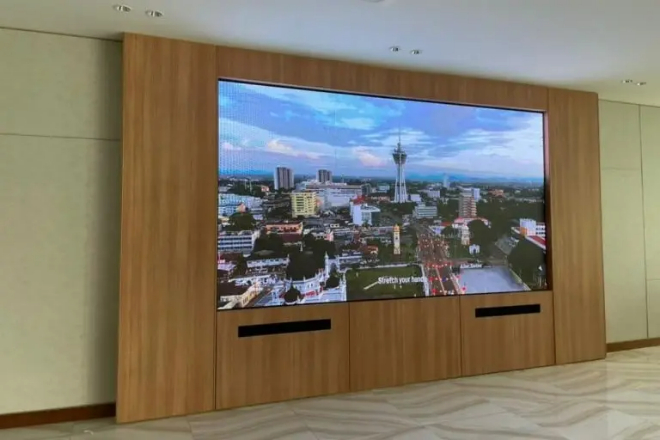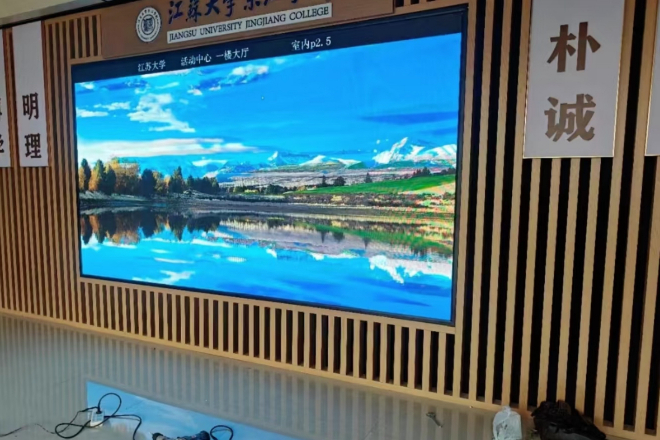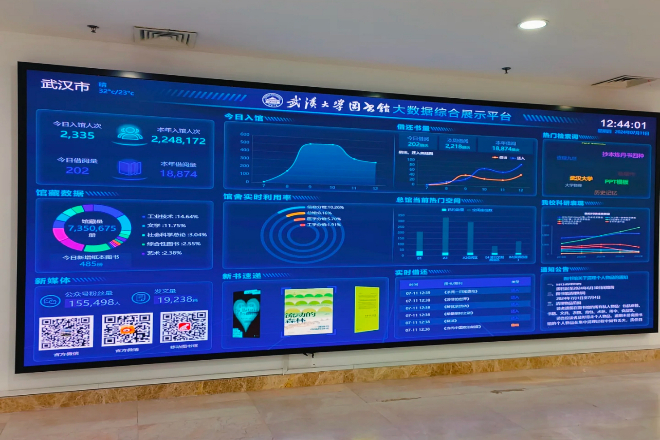序章
Traditional library information display methods, such as bulletin boards and banners, are concise and clear, but they have limitations in terms of information update speed, display effect, and interactivity.
の出現 LED表示 screens provides libraries with a new, more flexible, and diverse information display platform. However, the question also arises: What kind of LED display screen is suitable for libraries?
1. What are the library's requirements for LED display screens?

1). Information display requirements
The library has a lot of information and updates quickly, so LED display screens come in handy. After the traditional banner in front of the gate is replaced with an LED screen, event information, opening hours, and special notices can be displayed in real-time.
The content is diverse and fresh, and the library looks more fashionable. The large screen in the lobby loops the entrance instructions, collection guide, and the latest notices, which readers can see as soon as they enter the door, which is convenient and fast.
The guide screen in the reading room is even more practical. The collection location and temporary notices are clear at a glance, which makes it much faster to find books and materials.
2). Environmental adaptability requirements
The environment in the library is special, and the 輝度、 temperature, and humidity must be considered when choosing an LED display screen. The screen cannot be too bright or dazzling. You have to choose a screen that is comfortable to look at and friendly to the eyes.
The temperature and humidity in the library are stable, but you have to choose a screen that can adapt to some changes. After all, it will be used for a long time. In addition, the screen design must match the style of the library and not make it too abrupt, which will destroy the reading atmosphere.
3). Maintenance and management requirements
When managing LED display screens, libraries need to consider whether maintenance and management are convenient. The screen should be easy to install and adjust and easy to repair if there is a problem so that the management cost is low.
It is best to be able to control it remotely, and content updates and mode adjustments can be made online so that there is no need to run to the site all the time, and management efficiency is also improved.
Therefore, when choosing LED display screens, libraries must consider these aspects comprehensively and find a solution that suits them.
2. Recommendation of LED display screens suitable for installation in libraries

When choosing LED display screens, libraries should fully consider their information display needs, environmental adaptability, and convenience of maintenance and management.
The following are recommendations for LED display screens suitable for installation in libraries:
1). Indoor full-color LED display screen
- 利点:
Rich colors, realistic pictures, and the ability to perfectly present multimedia content, such as high-definition pictures and videos, creating a more vivid and attractive information display environment for the library.
- アプリケーションシナリオ:
It is very suitable for installation in the lobby of the library as a large screen display to play multimedia content such as library event announcements, collection introductions, new book recommendations, etc.
A guide screen can also be set up in the reading room to provide readers with practical information such as collection guidance and temporary notifications.
2). Asynchronous control LED display
- 利点:
It has independent control capabilities and does not require real-time connection to a computer. It is suitable for displaying fixed or infrequently updated information. This display is easy to operate and has low maintenance costs, which is very suitable for some specific application scenarios of the library.
- アプリケーションシナリオ:
Banner replacement in front of the gate is a typical application scenario. The use of a movable asynchronous control LED display can flexibly display fixed information such as the library’s opening hours and special events.
In addition, this display can also be used in the fixed notification column inside the library for long-term display of fixed content such as some rules and regulations, safety tips, etc.
3). Embedded or wall-mounted LED display
- 利点:
It saves space, is beautiful and generous, can be integrated with the overall environment of the library, and will not destroy the reading atmosphere of the library. This installation method is also easy to maintain and repair.
- アプリケーションシナリオ:
The walls of libraries, the sides of bookshelves, and other locations are very suitable for embedded or wall-mounted LED display screens.
For example, installing a guide screen on the side of the bookshelf can help readers obtain relevant collection information when looking for books; installing a notification screen on the wall of the library can publish some important notifications and announcements in real time.
- 利点:
This display has high resolution and seamless splicing technology, which can provide delicate and coherent visual effects, suitable for displaying detailed images and videos, and enhancing the audience’s visual experience.
- アプリケーションシナリオ:
In libraries, small-pitch LED displays are suitable for areas that require high-definition picture quality and detailed display, such as exhibition halls or high-end reading areas, for playing high-definition videos or displaying works of art.
- 利点:
Flexible displays, with their bendable and lightweight characteristics, can adapt to various irregular installation environments. Not only does it have good visual effects, but it also provides innovative display methods.
- アプリケーションシナリオ:
In libraries, flexible LED displays can be used for creative displays or interactive areas, such as curved walls or specially designed display areas, to provide readers with a unique visual experience.
In summary, when choosing an LED display screen, the library should choose the appropriate display type and installation method according to its specific needs and scene characteristics.
Indoor full-color LED display screens are suitable for multimedia content display, asynchronous control LED display screens are suitable for fixed or infrequently updated information display, and embedded or wall-mounted LED display screens are suitable for scenes that save space and need to be integrated with the environment.
3. Installation and maintenance of LED display screens in libraries

1). Installation process
Installing an LED display screen in a library is actually like completing a fine handicraft, which requires patience and carefulness, step by step:
1.1). Site survey:
First, you have to take a look around the library to see which location is most suitable for installing the LED display screen.
The foyer is a good choice, which is conspicuous and convenient; the entrance to the reading room is also good, and readers can see it as soon as they enter the door; the wall is also fine, as long as it does not affect reading and walking.
After determining the location, you have to measure how long the signal line should be. From the display screen to the control room, or to the network access point, all must be measured accurately so that the appropriate cable can be selected.
1.2). Design and wiring:
After selecting the cables, you have to plan how to route them. The cables must be neatly laid out, not tangled like a spider web. You can run them along the corners of the wall or hide them in the ceiling, but you have to make sure that people can’t see them.
The cables must also be protected so that people don’t trip over them or rats bite them. You can use cable troughs or cable tubes to protect the cables, which is both beautiful and safe.
1.3). Install the screen:
First, install the frame firmly, and use expansion screws or other fixings to firmly fix the frame to the wall or the ground. The frame must be installed horizontally, not crooked.
Then, put the LED screen together piece by piece, like a puzzle. When putting it together, pay attention to alignment and leave no gaps. After connecting the power supply and control lines, check whether there are any wrong or loose connections.
Finally, turn on the power to see if the screen is bright and the color is correct. If there is a problem, you need to adjust or replace it in time.
1.4). Debug the system:
The power supply system must be adjusted steadily, and it should not be bright and dark at the same time. You can use a multimeter to measure the voltage and current to ensure that they are within the normal range.
The display system must also be adjusted, and the words and pictures must be clear. You can play some test pictures or texts to see the display effect.
The network system must also be unobstructed, and remote control and content updates depend on it. You can try to change the content on the display through remote control.
2). メンテナンス
After installation, you still have to take care of it regularly, just like treating your own baby:
2.1). Regular inspection:
Every once in a while, you have to check whether the screen is still bright and whether there are dark spots or bright spots. The colors are uneven. Is there any color cast or discoloration? Is the picture clear? Is there any blur or jitter?
Check the frame and wires to see if they are loose, broken, or aged. In particular, check the frame fixings to see if they are loose or falling off.
Check the power supply and control system to see if they are normal. You can use a multimeter to measure the output voltage and current of the power supply to see if they are within the normal range. You should also try to see if the control system can work normally, such as whether it can receive remote commands, whether it can change the display content, etc.
2.2). Cleaning and maintenance:
The screen needs to be wiped regularly with a soft cloth dipped in water, not too wet. Wipe gently when wiping; don’t rub hard to avoid scratching the surface of the screen.
If there are stubborn stains or dust on the screen, you can use a special cleaner to clean it, but be careful not to let the cleaner flow into the screen.
Especially for outdoor screens or screens near doors and windows, there is a lot of dust, so you need to be more diligent. You can wipe it once a day or a week to keep the screen clean and tidy.
In addition to the screen surface, the heat sink or fan behind the screen should also be cleaned to prevent dust accumulation from affecting the heat dissipation effect.
2.3). Troubleshooting:
If there is a problem with the screen, such as a flowery screen, wrong color, black screen, etc., you have to deal with it quickly. First, you have to see if it is a problem with the power supply or control system. You can try to change the power supply or restart the control system to see if the problem can be solved.
If it is not a problem with the power supply or control system, then you have to see if it is a problem with the screen itself. You can check whether the connection cable of the screen is loose or broken, or check whether the module on the screen is damaged or aged.
If you can’t do it yourself, you have to find a professional to repair it. You can contact the manufacturer or maintenance service provider of the display screen and ask them to help with inspection and repair. Don’t think about it or dismantle and repair it randomly so as not to make the problem bigger.
In addition, in order to make the LED display screen last longer in the library, you have to pay attention to a few points:
Don’t always turn on the display screen without playing content or playing all-white and all-bright content, which will easily make the LED tube age faster. You can set some timer switches or brightness adjustment functions to extend the service life of the display screen.
The environment should be dry and ventilated, not too humid or too hot. If the environment is too humid or too hot, it will easily affect the normal operation and service life of the display. You can install some dehumidifiers or air conditioners to adjust the humidity and temperature of the environment.
Electromagnetic radiation should also be kept away. If there are some devices or devices with strong electromagnetic radiation near the display, it is easy to interfere with the normal operation of the display. You can try to move these devices or devices away or take some shielding measures to reduce the interference of electromagnetic radiation.
Library staff also need to learn how to use and repair the display. In this way, they can solve problems by themselves without always looking for professionals to repair them. Some training or learning activities can be organized to improve the skills and level of staff.
結論
In summary, when choosing to install LED display screens, libraries need to consider the type, characteristics, and actual needs of the display screens fully. Indoor full-color LED display screens have become the first choice for areas such as library foyers and reading rooms due to their rich colors and realistic pictures.
A synchronous control LED display screens are suitable for displaying fixed or infrequently updated information due to their independent control and no need for real-time connection. At the same time, embedded or wall-mounted installation can save space, look beautiful, and blend into the library environment.
最後に、LEDディスプレイスクリーンについてさらに詳しく知りたい場合は、 ご連絡ください。
